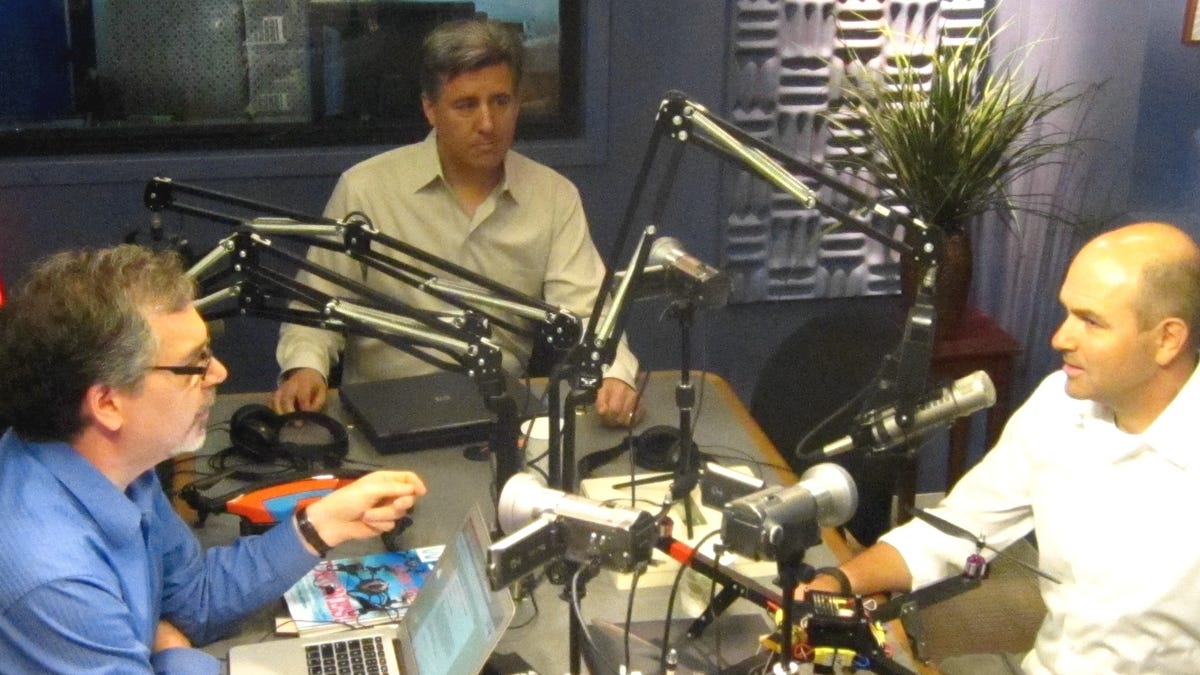Flying drones getting smaller, smarter, cheaper, and scarier
Thank the development of smartphones -- with their cheap sensors, abundant computing power, and numerous radios -- for the growth of both hobby and military tiny drones.

A little more than a year ago, we did a Roundtable episode on aerial drones and UAVs. The discussion mostly focused on how remote-controlled and robotic vehicles were getting bigger, more capable, and more scary. Since then, a funny thing happened. The drone revolution downsized. Today we're talking about cheap and small drones. Today, perhaps, a collection of a hundred $1,000 drones can be just as capable -- and just as scary -- as a $100,000 drone.
There is both a hopeful upside and a terrifying dark side to the rapid advances in small, cheap drones. We covered both on this episode of Reporters' Roundtable. Our guests: Chris Anderson, editor-in-chief of Wired Magazine and the founder of the DIY Drones community site (and its retail arm, 3D Robotics); and Daniel Suarez, author or the new geek thriller, Kill Decision, which features swarms of drones gone bad. Very bad.
As Anderson points out, many of the toy remote-controlled airplanes out there are "just one box away from becoming drones." Not coincidentally, Anderson's company, 3D Robotics, makes such a box, the ArduPilot Mega. It's a $200 controller that, "allows the user to turn any fixed, rotary wing or multirotor vehicle into a fully autonomous vehicle."
It's the ubiquity of this technology that was one of the inspirations for Suarez's book, which is in part about, "the miniaturization of war," as he says. Our own military is now, in fact, developing an air-fired missile specifically to launch from drones.
There's only a slight overlap between the hobbyist drone and the war drone, Suarez says.
Podcast
Subscribe:
iTunes (MP3)
iTunes (HD)
Podcast RSS (MP3)
Podcast RSS (HD)
Anderson, who's part of a community of drone builders, maintains that the aircraft are being used in plenty of nonaggressive applications, such as filming (like in car commercials) and environmental monitoring. These products give people, "anytime, anywhere access to the sky," he says.
There are very few drones over our cities. Commercial interests are not allowed to fly overhead. Nor most local governments. Hobbyists can, if they keep their drones under 400 feet. And the skies will eventually open up to everyone. "Ironically, my 9-year-old can fly drones, but the police department can't." Anderson says.
The problem is that our airspace is governed by a policy called sense-and-avoid. Flying vehicle control systems -- be they people or computers -- are ultimately responsible for avoiding other vehicles. And today's drones, as a rule, have no facility to make them aware of other aircraft.
Anderson says there is still a long way to go when it comes to autonomous vehicles. The videos we've seen of quadcopters flying through tiny slits or playing instruments are taken in highly controlled environments, he says.
Out in the real world, GPS and wind leads to much less precise positioning.
Suarez, in his book -- which is fiction, mind you -- added a new tool to the drone developer: Stigmergy, or a drone's capability to lay down a marker that other drones can read as a reinforcer to their behavior (in the case of the book Kill Decision, that's generally the order to attack someone). He's aware that he took poetic license, but he does believe this idea could be "just over the horizon." He also posits that autonomous drones can be built so cheaply and with so many off-the-shelf components that they can be built as untrackable, leading to "anonymous conflict."
The fact that a drone can serve a person, or group, without ratting them out has huge benefits, though. Suarez points out that while it is legal to videotape the police as they perform their jobs, citizens still do get harassed and arrested when they do so. When the videotaping is being done by an autonomous bot with no obvious controller, there's no one to arrest.
Anderson says we can credit the smartphone for the rise of drones. He believes a smartphone -- with its numerous sensors, communications links, and its computing power -- is essentially everything you need for a drone minus the propulsion system. "By coattailing on the smartphone industry," he says, the control system for a drone will become, "ultimately disposable."
"It's going to get pretty weird," Suarez says, as civil groups begin to have conflicts over drones. He says the police forces could begin to try to jam drones; less-restrained groups might simply shoot them out of the sky. Anderson also points out that popping "a flying lawnmower with spinning blades over the head of a crowd, possibly operated by amateurs, is a really bad idea."
Anderson says it's unlikely that we will soon have "Occupy Wall Street with their air force, and the police with theirs, drones battling in the skies... that would be kind of dangerous."
Watch the video interview with Anderson and Suarez for full details on all these topics.

